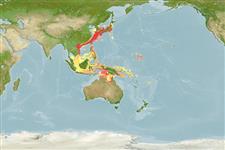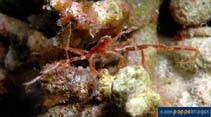Eplumula phalangium (de Haan, 1839)
| Native range | All suitable habitat | Point map | Year 2050 |

|
| This map was computer-generated and has not yet been reviewed. |
| Eplumula phalangium AquaMaps Data sources: GBIF OBIS |
Classification / Names Common names | Synonyms | CoL | ITIS | WoRMS
Malacostraca | Decapoda | Latreilliidae
Environment: milieu / climate zone / depth range / distribution range Ecology
Benthic; depth range 30 - 307 m (Ref. 84669). Subtropical
Distribution Countries | FAO areas | Ecosystems | Occurrences | Introductions
Western Pacific: Japan and Southern Korea to Taiwan and the Philippines.
Length at first maturity / Size / Weight / Age
Maturity: Lm ? range ? - ? cm Max length : 1.2 cm CL male/unsexed; (Ref. 84670); 1.4 cm CL (female)
Life cycle and mating behavior Maturity | Reproduction | Spawning | Eggs | Fecundity | Larvae
Main reference
References | Coordinator | Collaborators
Castro, P., A.B. Williams and L.L. Cooper 2003 Revision of the family Latreilliidae Stimpson, 1858 (Crustacea, Decapoda, Brachyura). Zoosystema 25(4):601-634. (Ref. 77901)
IUCN Red List Status
(Ref. 130435: Version 2025-1)
CITES status (Ref. 108899)
CMS (Ref. 116361)
Threat to humans
Human uses
| FishSource |
Tools
More information
Diet composition
Food consumption
Predators
Max. ages / sizes
Length-weight rel.
Length-length rel.
Length-frequencies
Mass conversion
Abundance
Internet sources
BHL | BOLD Systems | CISTI | DiscoverLife | FAO(Publication : search) | Fishipedia | GenBank (genome, nucleotide) | GloBI | Gomexsi | Google Books | Google Scholar | Google | PubMed | Tree of Life | Wikipedia (Go, Search) | Zoological Record



